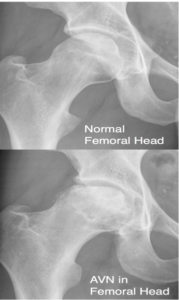
A Hip Bone Graft is used to replace pieces of bone that have died or are infected. A piece of healthy bone will be taken from another part of the body and used to fill the void space in the hip.
What is it?
Osteonecrosis also know as Avascular Necrosis, is a disease that affects bones. This condition is responsible for bone death and deterioration. The top of the leg bone (femoral head) that fits into the hip socket begins to break down and die. This bone death usually occurs because the blood supply is cut off to that part of the bone. Lack of blood supply could be due to some reasons such as blood clots, a trauma that severs the blood vessels in the bone, and radiation therapy that damages the vessels. Bone Grafting can help to replace the dead bone with vascularized bone, typically taken from the fibula.
What should I do to prepare?
Preparing for any surgery can be stressful. It is best to understand and talk with your doctor about what will happen during the surgery and what to expect after it is complete. Having a family member or close friend with you the day of surgery can help alleviate some stress. Scans and preoperative testing will be conducted to determine the best approach to remove the necrotic bone from the hip. A patient should not eat or drink after the midnight before surgery. Crutches and walkers will be recommended for weeks following the surgery to let the new bone heal and prevent fractures. This may require time off from work and other physical activities.
What happens during the process?
A patient undergoing bone graft surgery will not be conscious during the procedure. A surgeon will start by clearing out the dead and dying bone in the hip/femoral head. After that is complete, a piece of bone will be taken from another part of the body (usually the fibula). That bone will then be connected to the void space where the necrotic bone was taken from. Blood vessels will be reattached, and blood flow will be restored to that area.
What are the risks and possible complications?
Any surgery involving bones, muscles, or tendons will pose a risk for re-injury or injury to another part of the surrounding area. Infections, bleeding, and loss of function are possible with this surgery. Rejection of the bone graft is also a possibility with Hip Bone Graft Surgery. There is also the chance that there will be damage to blood vessels and nerves in the leg and hip. There is the chance that further surgery may need to be done later down the road to remove any excess bone growth that occurs during the healing process.
Disclaimer:
All GlobeHealer Site content, including graphics, images, logos, and text, among other materials on the site are only for education purposes. This content is not intended to be a substitute for professional medical advice, and you should always contact your physician or qualified health provider for information regarding your health. Information on this site regarding the overview, diagnosis, and treatment of any kind should be looked at, in addition to the advice and information of your health care professional. Do not disregard medical advice or delay seeking treatment or medical advice due to information found on the GlobeHealer site.
If there is even the possibility that you may have a medical emergency, seek treatment, call your doctor, or call your local emergency telephone number immediately. GlobeHealer does not endorse being the first line of communication in case of emergency and does not endorse any specific test, physician, facility, product, procedure, opinion, or other information that is or may be mentioned on this site or affiliated entities. Reliance of any and all information provided by GlobeHealer, its employees, affiliations, others appearing on the Site under the invitation of GlobeHealer, or visitors of the site is solely at your own risk and is not the responsibility of GlobeHealer.
Image Source:
https://upload.wikimedia.org/wikipedia/commons/4/4b/Hip_Avascular_Necrosis.jpg
